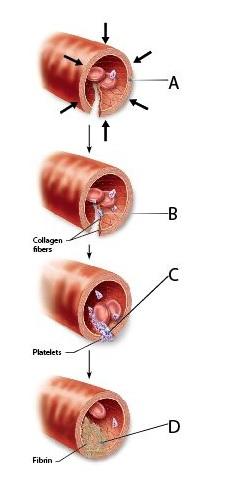In a centrifuged sample of blood, what should NOT be in the plasma portion of the sample?
platelets
Which of the following is NOT a function of blood?
hormone production
Athletes who choose to use industry-produced EPO as a performance-enhancing drug to increase the effects of their naturally-produced EPO, will experience ______.
decreased production of EPO by their kidneys
Which of the formed elements is present in the greatest concentration?
erythrocytes
Which of the following is NOT a functional characteristic of leukocytes?
leukocytosis
Which leukocyte might you expect to find in higher quantities in a person experiencing allergies?
eosinophil
Mature erythrocytes lack a nucleus. T/F
True
Choose the statement that is true concerning hemoglobin.
It is composed of four protein chains and four heme groups.
Which of the following does NOT stimulate erythrocyte production?
hyperventilating
Bilirubin is created when red blood cells are recycled. How is it removed from the blood stream?
the liver
Which of the following is correctly matched?
pernicious anemia: results from a vitamin B12 deficiency
Abnormally low levels of erythrocytes caused by excessive bleeding is called______.
hemorrhagic anemia
On a blood smear slide prepared using Wright's stain, you observe a large cell with a U-shaped nucleus and pale blue cytoplasm. This cell is most likely a(n) __________.
monocyte
Which of the following scenarios could result in HDN (hemolytic disease of the newborn)?
B-negative female pregnant with an AB-positive baby
Choose the incompatible transfusion.
Donate type B blood to a recipient with type O blood
When a person has an acute bacterial infection, such as bacterial meningitis or appendicitis, which type of leukocyte increases in number?
neutrophils
Which type of leukocyte is responsible for antibody production?
lymphocytes
Which of these develops from lymphoid stem cells?
lymphocytes
From which cell do the granulocytes descend?
myeloblast
What part of the pathway to produce platelets is shared with other formed elements?
hematopoietic stem cell (hemocytoblast)
What triggers erythropoietin (EPO) production to make new red blood cells?
reduced availability of oxygen
Which part of the hemoglobin molecule binds carbon dioxide for transport?
amino acids of the globin
What part of the body does erythropoietin (EPO) target to increase erythropoiesis?
bone marrow
What part of the hemoglobin molecule is eventually metabolized to stercobilin in the feces?
a portion of the heme group
What erythrocyte production disorder results from an autoimmune disease associated with vitamin B12 absorption?
pernicious anemia
What protein involved in coagulation provides the activation for the final step in clotting?
thrombin
All lymphocytes are also leukocytes. T/F
True
What factor stimulates platelet formation?
thrombopoietin
Which of the following represents a difference between extrinsic and intrinsic blood clotting pathways?
One is faster than the other.

During which event of hemostasis do clotting factors (procoagulants) assist with the transformation of blood from a liquid to a gel?
D
What "clot buster" enzyme removes unneeded clots after healing has occurred during fibrinolysis?
plasmin
During erythroblastosis fetalis, a Rh- mother's anti-Rh antibodies that have crossed the placenta will cause agglutination of the fetus's Rh+ RBCs. However, the reverse problem never happens when a Rh+ mother is pregnant with a Rh- fetus, that is, antibodies produced by the fetus cannot cause agglutination of the mother's Rh+ RBCs. This is true because ______.
antibodies that can cause this agglutination are not produced by a fetus
Which ABO blood type is considered to be the universal recipient?
AB
Digesting a clot after it is formed requires activation of what plasma protein by tPA?
plasminogen
Which of the following would NOT lead to a bleeding disorder?
excess calcium in the diet
A person who lacks agglutinogen A but has agglutinogen B would have blood type __________.
B
What is a hematocrit?
Hematocrit is the percentage of erythrocytes in a whole blood sample.
Which plasma constituent is the main contributor to clotting?
fibrinogen
Which of these represents the majority of whole blood by volume?
plasma
Plasma typically constitutes 55% of whole blood, although this value can vary somewhat.
Which of the following is true of the structure of an erythrocyte?
Erythrocytes can bend and twist to fit through vessels.
What is the name of the protein found in erythrocytes that transports respiratory gases?
hemoglobin
How many oxygen molecules can be transported by one hemoglobin molecule?
four
Which formed element can be described as membrane-enclosed cytoplasmic fragments?
platelets